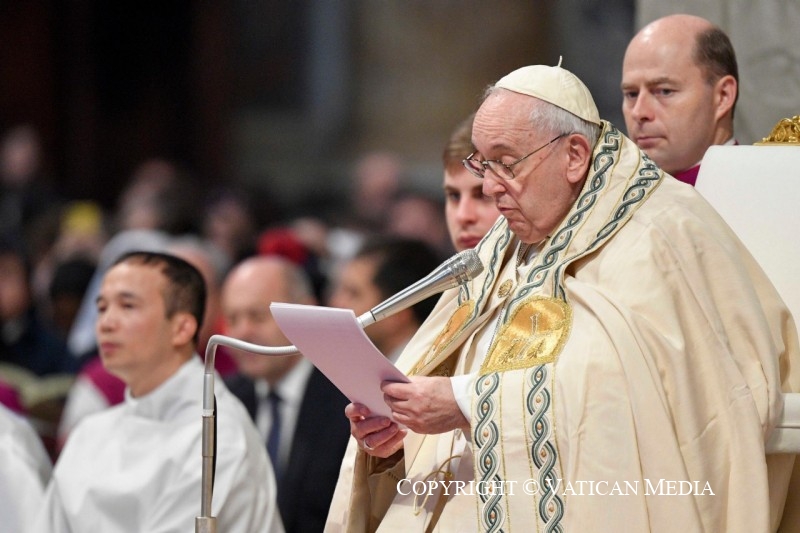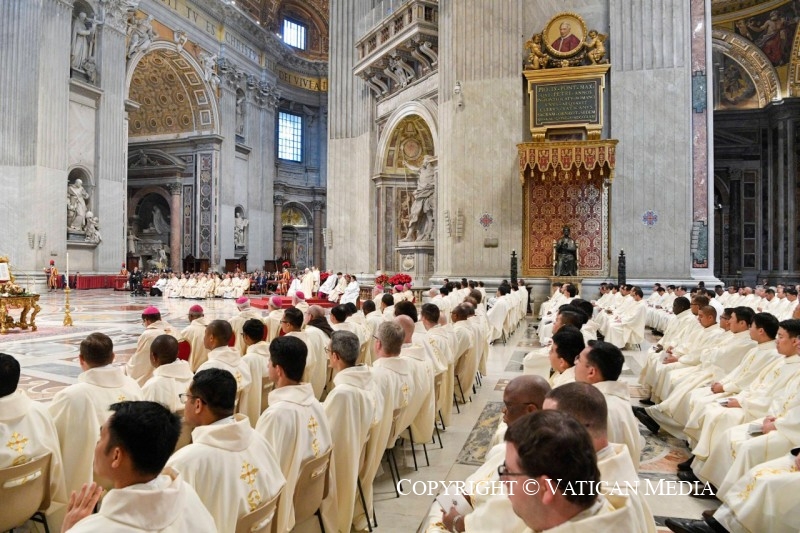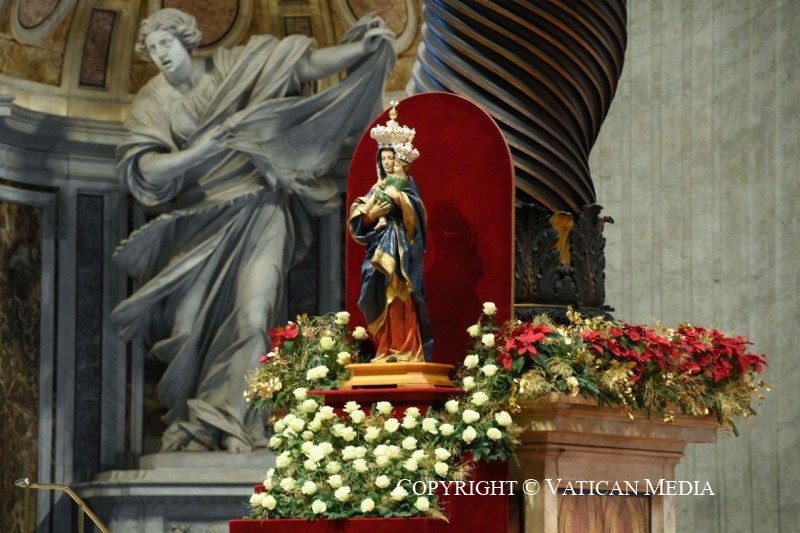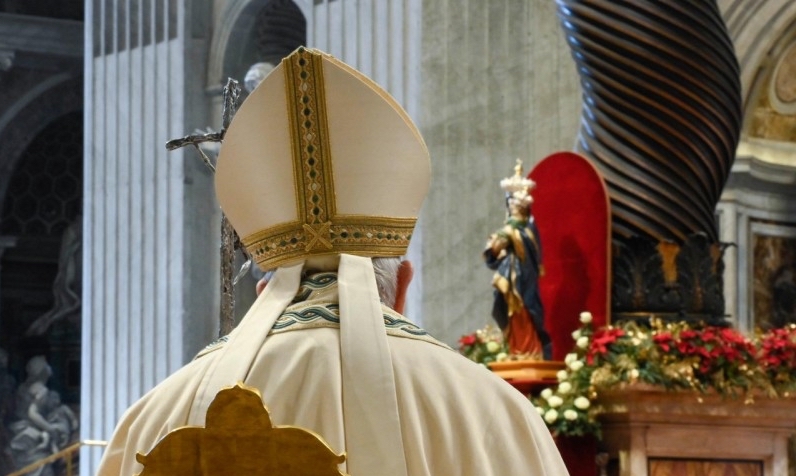(ZENIT News / Vatican City, 01.01.2023).- The Mass, held on the Solemnity of Mary, Mother of God, presided over by Pope Francis, was held ay 10:00 am in the Vatican Basilica. Observed also on January 1 was the 56th World Day of Peace.
Here is the Holy See’s translation into English of the Holy Father’s homily, with phrases in bold added by ZENIT.
* * *
Holy Mother of God! This was the joyful acclamation of the holy People of God echoing in the streets of Ephesus in the year 431, when the Council Fathers proclaimed Mary the Mother of God. This truth is a fundamental datum of faith, but above all, it is a marvellous fact. God has a Mother and is thus bound forever to our humanity, like a child to its mother, to the point that our humanity is His humanity. It is an amazing and consoling truth, so much so that the most recent Council, which met here in Saint Peter’s, stated that, “by his incarnation, the Son of God has in a certain way united Himself with each individual. He worked with human hands, He thought with a human mind, He acted with a human will, and loved with a human heart. Born of the Virgin Mary, He truly became one of us, like us in all things except sin” (Pastoral Constitution Gaudium et Spes, 22). That is what God did by being born of Mary: He showed His concrete love for our humanity, embracing it truly and fully. Brothers and sisters, God does not love us in words but in deeds; not from “on high”, but “up close”, precisely from “within” our flesh, because in Mary the Word became flesh, because Christ continues to have a heart of flesh that beats for each and every one of us!

Holy Mother of God! Many books and weighty tomes have been written about this title of Our Lady. Yet these words have mostly entered the minds and hearts of the holy People of God through the simple and familiar prayer that accompanies the rhythm of our days, our moments of weariness and our greatest aspirations: the Hail Mary.
After a few phrases drawn from the word of God, the second part of the prayer continues: “Holy Mary, Mother of God, pray for us sinners . . . ” This invocation, often repeated throughout the day, has allowed God to draw near, through Mary, to our lives and our history. Mother of God, pray for us sinners . . . It is recited in the most diverse languages, on the beads of a Rosary and at times of need, in the presence of a holy image or walking along the way. To this invocation the Mother of God always responds; She hears our petitions; holding her Son in her arms, She blesses us and brings us the tender love of God made flesh. In a word, Mary gives us hope. At the beginning of this year, we need hope, just as the earth needs rain. This year that opens with the celebration of God’s Mother and our own, tells us that the key to hope is Mary and that the antiphon of hope is the invocation, Holy Mother of God. And today, we entrust beloved Pope Emeritus Benedict XVI to our Most Holy Mother, that She will accompany him on his journey from this world to God.
Let us pray to our Mother in a special way for her sons and daughters who are suffering and no longer have the strength to pray, and for our many brothers and sisters throughout the world who are victims of war, passing these holidays in darkness and cold, in poverty and fear, immersed in violence and indifference! For all those who have no peace, let us invoke Mary, the woman who brought into the world the Prince of Peace (cf. Isaiah 9:6; Galatians 4:4). In her, the Queen of Peace, was fulfilled the blessing we heard in the first reading: “May the Lord lift up his countenance upon you, and give you peace” (Numbers 6:26). At the hands of a Mother, God’s peace wants to enter into our homes, our hearts and our world. Yet what must we do to receive that peace?
Let us be guided by the people we meet in today’s Gospel, who were the first to see the Mother and Child: the shepherds of Bethlehem. They were poor people and perhaps somewhat uncouth, and that night they were working. Yet they, not the learned or the powerful, were the first to recognize God among us, the God who became poor and loves to be with the poor. The Gospel emphasizes two very simple things that the shepherds did: things simple but not always easy. They went and saw. Two actions: going and seeing.

[The shepherds went]
First, going. The Gospel tells us that the shepherds “went with haste” (Luke 2:16). They did not wait around. It was night, they had their flocks to keep, and naturally they were weary: they could easily have waited for dawn, held off until sunrise in order to go and see the Child lying in the manger. Instead, they went with haste, because where important things are concerned, we need to react promptly and not wait, for “the grace of the Spirit brooks no delay” (Saint Ambrose, Commentary on Saint Luke, 2). And so they encountered the Messiah, the one awaited for centuries, the one that so many others had long sought.
Brothers and sisters, if we are to welcome God and his peace, we cannot stand around complacently, waiting for things to get better. We need to get up, recognize the moments of grace, set out and take a risk. We need to take a risk! Today, at the beginning of the year, rather than standing around, thinking and hoping that things will change, we should instead ask ourselves: “This year, where do I want to go? Who is it that I can help?” So many people, in the Church and in society, are waiting for the good that you and you alone can do, they are waiting for your help. Today, amid the lethargy that dulls our senses, the indifference that paralyzes our hearts, and the temptation to waste time glued to a keyboard in front of a computer screen, the shepherds are summoning us to set out and get involved in our world, to dirty our hands and to do some good. They are inviting us to set aside many of our routines and our comforts in order to open ourselves to the new things of God, which are found in the humility of service, in the courage of caring for others. Brothers and sisters, let us imitate the shepherds: let us set out with haste!
[The shepherds saw]
When they arrived, the Gospel tells us, the shepherds “found Mary and Joseph, and the Child lying in the manger” (v. 16). It then says that “after having seen” the Child (cf. v. 17), they set out, filled with wonder, to tell others about Jesus, glorifying and praising God for everything that they had heard and seen (cf. vv. 17-18, 20). The important thing was that they had seen Him. What is important is to see, to look around and, like the shepherds, to halt before the Child resting in his mother’s arms. To say nothing, to ask nothing, to do nothing. Simply to look on in silence, to adore and to contemplate the tender and comforting love of God made man, and His, and our, Mother. At the beginning of this year, among all the other things that we would like to do and experience, let us devote some time to seeing, to opening our eyes and to keeping them open before what really matters: God and our brothers and sisters. Let us have the courage to experience the wonder of encounter, which is God’s style. That is something very different from the world’s seductions, which seem to calm us. The wonder of God and of encounter gives us peace; the world can only anesthetize us and give peace of mind.

How many times, in our busy lives, do we fail to stop, even for a moment, to be close to the Lord and to hear His word, to say a prayer, to adore and praise Him. We do the same thing with others: caught up in our own affairs or in getting ahead, we have no time to listen to our wife, our husband, to talk with our children, to ask them about how they really are, and not simply about their studies or their health. And how good it is for us to take time and listen to the elderly, to our grandfathers and grandmothers, in order to remember the deeper meaning of our lives and to recover our roots. Let us ask ourselves too, whether we are capable of seeing the people next door, the people who live in the same building, the people we meet each day on the street. Brothers and sisters, let us imitate the shepherds: let us learn to see! To understand by seeing with our hearts. Let us learn to see.
Going and seeing. Today the Lord has come among us and the Holy Mother of God sets Him before our eyes. Let us rediscover in the enthusiasm of going and the wonder of seeing the secret that can make this year truly “new,” and thus overcome the weariness of being stuck or the false peace of seduction.
And now, brothers and sisters, I invite all of you to look to the Virgin Mary. Let us invoke her three times, as the people of Ephesus did: Holy Mother of God! Holy Mother of God! Holy Mother of God!



